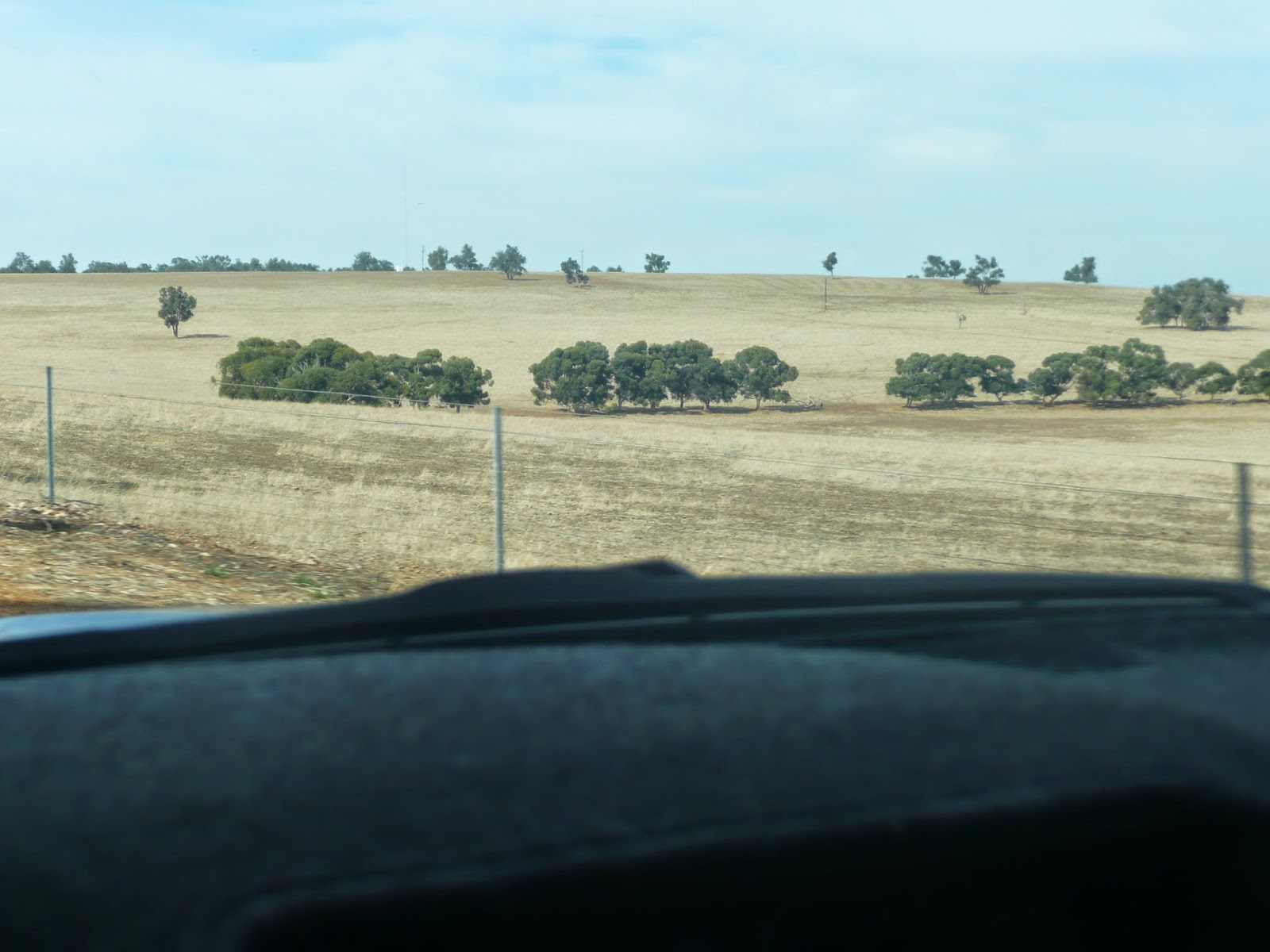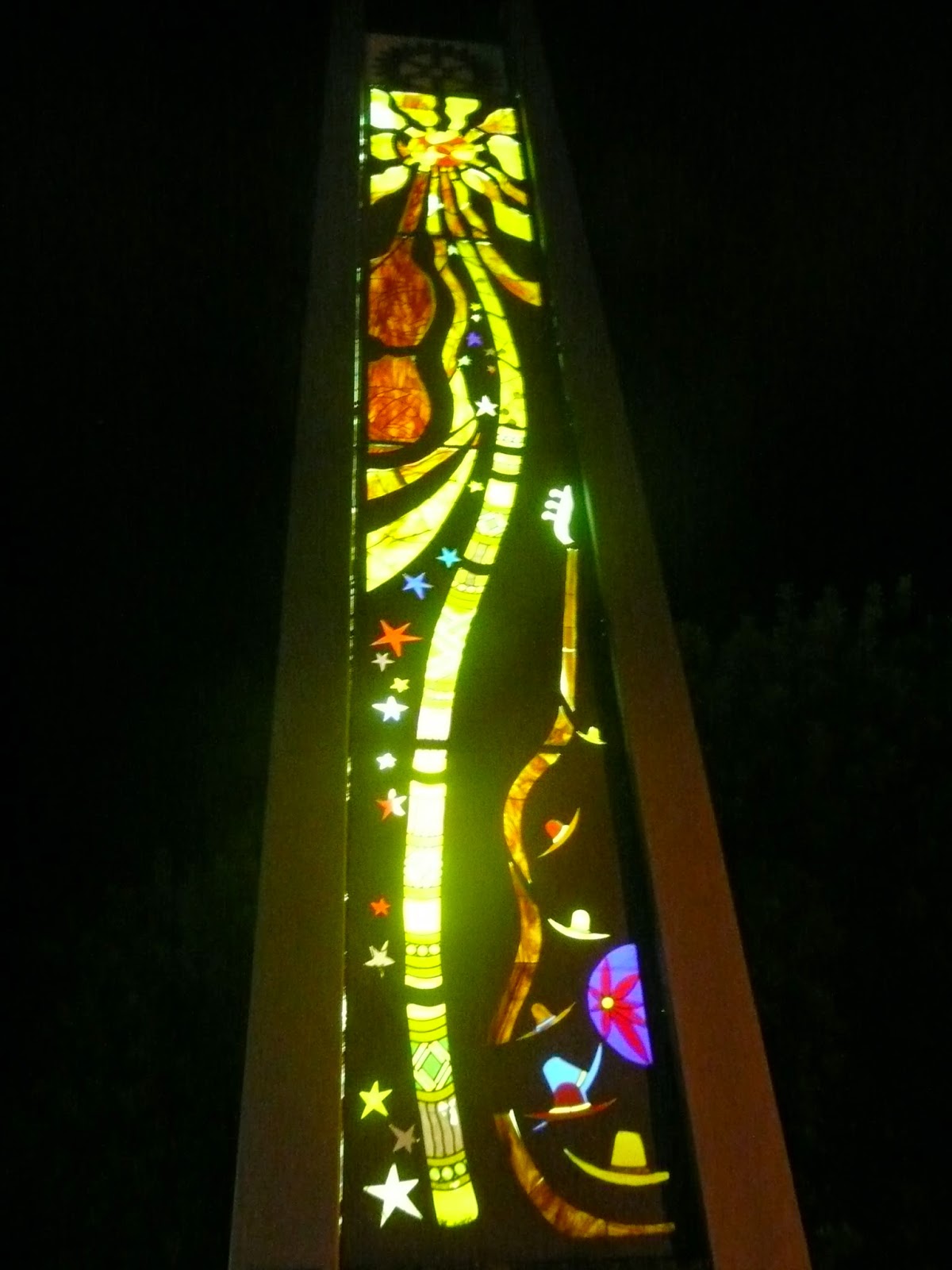We hauled out of Cervantes with ambivalent feelings. On the one hand we were sad to be leaving a spot we had enjoyed so much, whilst on the other we were relieved to be escaping the mounting chaos in the caravan park. In fact, during the course of a delightful and overly long pre-departure happy hour with Barbara and Bruce, the assistant park managers with whom we had become friendly during our stay, they had confided in us that they dread Easter.
For some unknown reason normally orderly children morph into holiday ratbags and normally responsible adults seem to think that, for some equally unknown reason, all parental responsibilities cease once the tent is up. It is a universal tale, the truth of which we have witnessed more than once.
So with our noses pointed away from the coast, we headed out through the last of the sand hill country we were to see for a while
inland through the rolling hills and grazing pastures to the east
Here the roadside trees assumed much larger proportions than the coastal heath we had experienced for the past couple of weeks as we neared the end of our 100 kms trip for the day and made our way into Moora.
As we neared the town we passed this roadside blaze of colour...potted bougainvillea along the front fence of the local cemetery.
In a short aside I would comment here that we have seen that this plant is used extensively in the west and seems to thrive in conditions we do not normally associate with it.
Apart from the arresting display at the cemetery, I later spotted other examples in the Moora township as in here at the Aged Care centre
But I am getting ahead of myself....back to our arrival. It is impossible on the approach to a new destination to avoid contemplating what lies immediately ahead for us. The questions always form in our minds, no matter that experience has now taught us that we can make do anywhere. Will we have grass? Will there be shade? What sort of shower heads do they have here? (this is of real importance and one thing we can't change...much can be forgiven or ignored if a good strong flow of hot water is on offer)
We were soon to find out as we approached the Moora Caravan park entrance roadway.
Past the local pool, unfortunately closed for the winter,
and on into the small, Shire owned park we drove. When we booked, Shirley, the park caretaker, actually measured out the site she had in mind for us and assured us that it would be long enough. She also made it clear that it would be reserved for our use only. With a welcome like this, we could easily forgive her the spelling error.
And our site was 'caravanning bliss'....a bitumen pad (actually the roadway), a beautifully grassed annex area, a huge shade tree and oodles of 'elbow room'.
And the outlook from our 'beer garden'.....just as good, as we gazed across the green expanses of the adjoining Apex Park.
We were very quick to decide that our decision to chose Moora as our place of Easter refuge has been a clever one indeed.

The Moora Shire Caravan park is indeed one out of the box. Apart from the excellent sites, the park boasts a number of new cabins,

a good amenities block and camp kitchen/BBQ area

The Moora Shire Caravan park is indeed one out of the box. Apart from the excellent sites, the park boasts a number of new cabins,

a good amenities block and camp kitchen/BBQ area

and delightful, well tended gardens here at the park entrance and
in large beds near the central amenities.
To top all this off we were invited to help ourselves to a few of the blooms for our afternoon drinks table.

What with fresh flowers, a parklands outlook, and frequent visits from colourful feathered friends, local ringneck parrots, our 'happy hours' at Moora were just that.
The park is compact but very well set out. There is no sense of crowding. It is set on the banks of the Moore River, which, when it is flowing, would add another dimension to the general ambiance. We were very happy in Moora.
The township itself, which is just under 200 kms north of Perth, is the largest inland service centre between the city and Geraldton. With a population of just under 2,000 and a catchment area in which over 6,000 people live, Moora boasts five banks, two primary schools, a senior high school, a residential college and all medical and dental services including a hospital. The huge CBH grain conglomerate operates a large receival station just out of the town to handle the produce of the surrounding wheatbelt farms.

Moora is also a town of parks, murals and its famous town clock which can just be seen here rising between the trees at the end of the short main commercial street (on a very quiet Good Friday afternoon)

This is an impressive bit of work. We wandered past the Drovers Inn, which has a far more attractive exterior than interior bar area,

and took a closer look. Each face of the clock is made of panels of coloured glass, and each face has its own theme.

This clock blazes into life at night. Here is the west face and its theme of flora,
whilst the southern aspect of the clock represents family.
The northern face has a musical theme,

and the eastern is ablaze with stylised aboriginal animal icons enclosed in the body of a standing water bird.

Beyond the clock (and obviously back in daylight) we wandered across the railway line and the old Moora railway station which is now the local Visitor Centre,
through a small park with its interesting butterfly statue,

to Moora's Centenary Park
where we found the town's Cross of Sacrifice
and this odd 'tin soldier' statue. What is this all about?
One of Moora's several town murals, painted on the wall of a service station opposite, provides some of the answer.
During WW2, Jurien Bay was identified as potential Japanese invasion point. As a result of this and for other reasons, over 25 military camps were established in Moora and its immediate surrounds. 17,000 troops were housed and trained in the area before leaving for different theatres of the conflict.

This history is also reflected at the Town Hall building, where,

on its northern side stands a wooden sign listing the various units stationed in the area.

As one would expect, the current Shire offices are next to the old town hall, fronted by a delightful rose garden.

And on the end wall of this building, yet another of Moora's town murals.

On the opposite corner, Federation Park

provides a venue in which the efforts of the draught horse and the cattle dog in developing the Moora area are celebrated, both in statue form and with another mural.
As can be seen by now, the parks in Moora alternate between those which are completely dry and others which are obviously irrigated throughout the season.

The gardens around the town Information Bay are a treat

and stand in complete contrast to the dry, open surrounds of the nearby St John's church.
As I have mentioned previously, Moora stands on the banks of the Moore River, completely dry at the time of our visit with the exception of a couple of isolated ponds. The Moore is usually a well behaved watercourse, but this has not always been the case.
The town has been flooded a few times, but nothing matched the 'one in 300 years' flood of 1999. And, as is the want of the good burghers of Moora, this too is depicted in a mural.
This flood really was a doozy. In the early hours of 21 March, 1999, the Moore burst its banks with totally unexpected speed and ferocity. Muddy waters completely inundated the town within hours, to the extent that the entire population was evacuated to a Perth hostel until the water receded. In fact 1999 was a bad year....the Moore made its presence felt again in late May and in mid August, but far less dramatically.

Let us finish this quick ramble around the town with two more murals, the first on the wall of the swimming pool complex,

and on the wall of the local grog shop, which for some strange reason is the host for a depiction of the wool industry.

This particular piece of local art seems to be in need of some touch up work, but somewhat gauche as is, I did like the caption.
One of the reasons we had chosen Moora for our Easter sojourn was its proximity to the monastic town of New Norcia, the location of our next adventure.














































